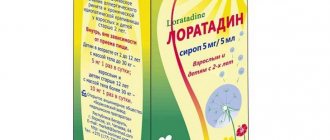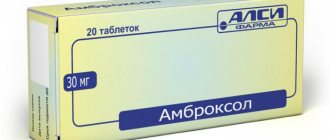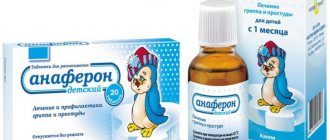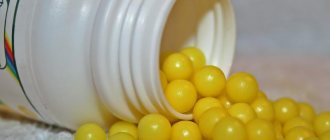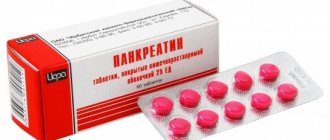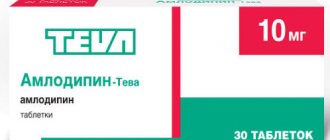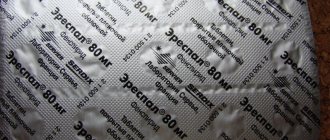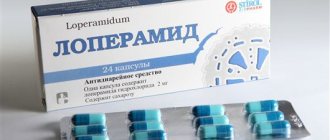pharmachologic effect
The drug contains acetazolamide, a systemic inhibitor. Thanks to this substance, bicarbonate ions are reduced. Thus, the transport of sodium into the cells practically stops. Also, thanks to acetazolamide, the gradient filtration of plasma decreases.
Basically, the description of the substance says that it is suitable for the treatment of glaucoma. With its help, there is a noticeable decrease in pressure inside the eyes, which significantly improves their condition. On average, the drug can lower blood pressure by 40-60%.
Sometimes doctors prescribe Diacarb for epilepsy attacks. The drug allows you to eliminate the cause and significantly alleviate the patient’s condition.
Synonyms of nosological groups
| Category ICD-10 | Synonyms of diseases according to ICD-10 |
| E87.3 Alkalosis | Hypokalemic alkalosis |
| Hypokalemic alkalosis with hypercalciuria | |
| Respiratory alkalosis | |
| Metabolic alkalosis | |
| Alkalosis in liver diseases | |
| Respiratory alkalosis | |
| Hypochloremic alkalosis | |
| Respiratory alkalosis | |
| Metabolic alkalosis | |
| G40 Epilepsy | Atypical seizures |
| Atonic seizures | |
| Grand mal seizures | |
| Grand mal seizures in children | |
| Grand mal seizures | |
| Generalized absence seizures | |
| Jacksonian epilepsy | |
| Diffuse grand mal seizure | |
| Diencephalic epilepsy | |
| Cortical and non-convulsive forms of epilepsy | |
| Primary generalized seizures | |
| Primary generalized seizure | |
| Primary generalized seizure | |
| Primary generalized tonic-clonic seizure | |
| Pycnoleptic absence | |
| Repeated epileptic seizures | |
| Generalized seizure | |
| Convulsive seizure | |
| Refractory epilepsy in children | |
| Complex seizures | |
| Mixed seizures | |
| Mixed forms of epilepsy | |
| Convulsive state | |
| Seizures | |
| Convulsive conditions | |
| Convulsive forms of epilepsy | |
| Grand mal epilepsy | |
| Epileptic seizures | |
| G93.2 Benign intracranial hypertension | Intracranial hypertension |
| Intracranial hypertension | |
| Increased intracranial pressure | |
| Persistent cerebral hypertension | |
| H40 Glaucoma | Antiglaucoma intervention |
| Aphakic glaucoma | |
| Narrow-angle glaucoma | |
| Chronic glaucoma | |
| Chronic open-angle glaucoma | |
| Wide angle glaucoma | |
| H40.9 Glaucoma, unspecified | Aphakia with glaucoma |
| Acute glaucoma | |
| Acute attack of glaucoma | |
| R60 Edema, not elsewhere classified | Painful swelling after injury or surgery |
| Painful swelling after surgery | |
| Dropsy | |
| Dystrophic nutritional edema | |
| Lymphostasis and swelling after breast cancer therapy | |
| Swelling due to sprains and bruises | |
| Edema due to the constitution | |
| Edema of renal origin | |
| Peripheral edema | |
| Edema-ascitic syndrome in liver cirrhosis | |
| Edema syndrome | |
| Edema syndrome intoxication | |
| Edema syndrome due to secondary hyperaldosteronism | |
| Edema syndrome of hepatic origin | |
| Edema syndrome in heart diseases | |
| Edema syndrome in congestive heart failure | |
| Edema syndrome in heart failure | |
| Edema syndrome in heart failure or cirrhosis of the liver | |
| Pastosity | |
| Peripheral congestive edema | |
| Peripheral edema | |
| Hepatic edema syndrome | |
| Premenstrual edema | |
| Cardiac edema syndrome | |
| Iatrogenic edema | |
| R60.9 Edema, unspecified | Dropsy of the joints |
| Inflammatory swelling of soft tissues | |
| Dysproteinemic edema | |
| Fluid retention in the body | |
| Fluid retention in obesity | |
| Edema | |
| Hypothyroid edema | |
| Edema of renal origin | |
| High altitude edema | |
| Edema syndrome in muscular-articular diseases | |
| Increased accumulation of fluid in body tissues | |
| T70.2 Other and unspecified effects of high altitude | Acclimatization to high altitudes |
| Barotraumatic osteonecrosis | |
| Acosta's disease (d'Acosta) | |
| altitude sickness | |
| Altitude sickness | |
| High altitude pulmonary edema | |
| Altitude sickness | |
| Retinal hemorrhages at altitudes | |
| Monkhe disease | |
| High altitude edema | |
| Z100* CLASS XXII Surgical practice | Abdominal surgery |
| Adenomectomy | |
| Amputation | |
| Angioplasty of coronary arteries | |
| Carotid angioplasty | |
| Antiseptic treatment of skin for wounds | |
| Antiseptic hand treatment | |
| Appendectomy | |
| Atherectomy | |
| Balloon coronary angioplasty | |
| Vaginal hysterectomy | |
| Corona bypass | |
| Interventions on the vagina and cervix | |
| Bladder interventions | |
| Intervention in the oral cavity | |
| Restorative and reconstructive operations | |
| Hand hygiene of medical personnel | |
| Gynecological surgery | |
| Gynecological interventions | |
| Gynecological surgeries | |
| Hypovolemic shock during surgery | |
| Disinfection of purulent wounds | |
| Disinfection of wound edges | |
| Diagnostic interventions | |
| Diagnostic procedures | |
| Diathermocoagulation of the cervix | |
| Long surgical operations | |
| Replacing fistula catheters | |
| Infection during orthopedic surgery | |
| Artificial heart valve | |
| Cystectomy | |
| Short-term outpatient surgery | |
| Short-term operations | |
| Short-term surgical procedures | |
| Cricothyroidotomy | |
| Blood loss during surgery | |
| Bleeding during surgery and in the postoperative period | |
| Culdocentesis | |
| Laser coagulation | |
| Laser coagulation | |
| Laser coagulation of the retina | |
| Laparoscopy | |
| Laparoscopy in gynecology | |
| CSF fistula | |
| Minor gynecological operations | |
| Minor surgical interventions | |
| Mastectomy and subsequent plastic surgery | |
| Mediastinotomy | |
| Microsurgical operations on the ear | |
| Mucogingival surgeries | |
| Stitching | |
| Minor surgeries | |
| Neurosurgical operation | |
| Immobilization of the eyeball in ophthalmic surgery | |
| Orchiectomy | |
| Complications after tooth extraction | |
| Pancreatectomy | |
| Pericardectomy | |
| Rehabilitation period after surgery | |
| The period of convalescence after surgical interventions | |
| Percutaneous transluminal coronary angioplasty | |
| Pleural thoracentesis | |
| Pneumonia postoperative and post-traumatic | |
| Preparing for surgical procedures | |
| Preparing for surgery | |
| Preparing the surgeon's hands before surgery | |
| Preparing the colon for surgery | |
| Postoperative aspiration pneumonia during neurosurgical and thoracic operations | |
| Postoperative nausea | |
| Postoperative bleeding | |
| Postoperative granuloma | |
| Postoperative shock | |
| Early postoperative period | |
| Myocardial revascularization | |
| Resection of the apex of the tooth root | |
| Gastric resection | |
| Bowel resection | |
| Resection of the uterus | |
| Liver resection | |
| Small bowel resection | |
| Resection of part of the stomach | |
| Reocclusion of the operated vessel | |
| Bonding tissue during surgery | |
| Removing stitches | |
| Condition after eye surgery | |
| Condition after surgery | |
| Condition after surgical interventions in the nasal cavity | |
| Condition after gastrectomy | |
| Condition after resection of the small intestine | |
| Condition after tonsillectomy | |
| Condition after removal of the duodenum | |
| Condition after phlebectomy | |
| Vascular surgery | |
| Splenectomy | |
| Sterilization of surgical instruments | |
| Sterilization of surgical instruments | |
| Sternotomy | |
| Dental operations | |
| Dental intervention on periodontal tissues | |
| Strumectomy | |
| Tonsillectomy | |
| Thoracic surgery | |
| Thoracic operations | |
| Total gastrectomy | |
| Transdermal intravascular coronary angioplasty | |
| Transurethral resection | |
| Turbinectomy | |
| Removal of a tooth | |
| Cataract removal | |
| Cyst removal | |
| Tonsil removal | |
| Removal of fibroids | |
| Removal of mobile baby teeth | |
| Removal of polyps | |
| Removing a broken tooth | |
| Removal of the uterine body | |
| Removing stitches | |
| Urethrotomy | |
| CSF duct fistula | |
| Frontoethmoidohaymorotomy | |
| Surgical infection | |
| Surgical treatment of chronic limb ulcers | |
| Surgery | |
| Surgery in the anal area | |
| Colon surgery | |
| Surgical practice | |
| Surgical procedure | |
| Surgical interventions | |
| Surgical interventions on the gastrointestinal tract | |
| Surgical interventions on the urinary tract | |
| Surgical interventions on the urinary system | |
| Surgical interventions on the genitourinary system | |
| Heart surgery | |
| Surgical procedures | |
| Surgical operations | |
| Vein surgery | |
| Surgical intervention | |
| Vascular surgery | |
| Surgical treatment of thrombosis | |
| Surgery | |
| Cholecystectomy | |
| Partial gastrectomy | |
| Transperitoneal hysterectomy | |
| Percutaneous transluminal coronary angioplasty | |
| Percutaneous transluminal angioplasty | |
| Coronary artery bypass surgery | |
| Tooth extirpation | |
| Extirpation of baby teeth | |
| Pulp extirpation | |
| Extracorporeal circulation | |
| Tooth extraction | |
| Tooth extraction | |
| Cataract extraction | |
| Electrocoagulation | |
| Endourological interventions | |
| Episiotomy | |
| Ethmoidotomy |
The medicine is dispensed according to a doctor's prescription. The shelf life of the drug is 5 years. The medicine should be stored out of the reach of children, protected from light. The optimal temperature is up to 25 degrees.
Indications for use of Diacarb
Doctors usually prescribe the drug in the following situations:
- when swelling of the eyes occurs;
- for various cases of glaucoma;
- during epilepsy attacks;
- for disorders occurring inside the skull.
Each patient, after consultation with a doctor, is prescribed appropriate treatment. The doctor also explains how to take the drug correctly and writes a prescription, which can then be taken to the pharmacy.
Terms of sale
To purchase Diacarb at a pharmacy, you must first obtain a prescription from your doctor. The average price of a package containing 30 tablets is 250 rubles.
To ensure that the medication does not lose its medicinal properties, a place hidden from light is selected for its storage, where the temperature is no more than 25 degrees. Such a place should be hidden from small children.
At a temperature not exceeding 25 °C.
Keep out of the reach of children.
tablets 250 mg - 5 years.
tablets 250 mg - 5 years.
Do not use after the expiration date stated on the package.
Contraindications and side effects
The use of the drug is strictly prohibited in the following cases:
- for problems with the kidneys or liver;
- with uremia;
- with hypokalemia.
The drug is also contraindicated for those suffering from diabetes and Addison's disease.
Side effects include:
- Increased bleeding.
- Impaired taste with subsequent loss of appetite.
- Nausea.
- Depression and lethargy.
- Irritability.
- Lost in space.
- Cramps.
- And many other side effects.
Sometimes the use of the drug threatens rashes on the surface of the outer layer of the epidermis. If the patient has severe signs of side effects, then you should definitely consult a doctor. It is possible that an allergic reaction occurs to some substance in Diakarb. This will serve as a reason to replace the drug with its analogue.
Side effects
"Diacarb" is one of the low-toxic drugs. During its use, convulsions, tinnitus, paresthesia and, in rare cases, myopia may occur. During long-term use - dizziness, disorientation, drowsiness, defects of touch.
In this case, you should refrain from driving or performing work that requires a high concentration of attention. Also, taking more than five days can cause the development of metabolic acidosis. In some cases, patients complain of various kinds of allergic reactions, muscle weakness, anorexia, nausea, vomiting, diarrhea, glucosuria, agranulocytosis, etc.
When used with diuretics, you need to take into account that Diacarb enhances their effect, and in the case of simultaneous use with acid-forming diuretics, on the contrary, it reduces it. No cases of drug poisoning or overdose have been identified.
Diacarb - instructions for use
The drug should be taken orally, preferably after meals. If one dose of the drug is missed, you should not increase the dosage of the drug with subsequent use.
Abstract of use for edema: the initial dose is 250 mg daily every morning. Sometimes the dose is increased. It is recommended to take it either once a day or alternating days.
Use for glaucoma
In this case, Diacarb is one of the components of complex therapy, and the dosage must be monitored by the attending physician, who prescribes a prescription depending on the patient’s age.
Adults: In the initial stages, it is recommended to take 250 mg of Diacarb up to a maximum of four times a day. If the disease is secondary, then the schedule for taking the drug is changed until it is consumed every four hours.
Children: if attacks occur, the doctor recommends using the medicine in an amount of 10-15 mg per 1 kg of the child’s body weight. Should be taken 3 times a day. The maximum daily dose is 4 doses of the drug.
Use for altitude sickness
Most often, the prescription prescribes a dosage of 500-1000 mg per day. If the ascent is rapid, then 1000 mg can be taken orally. You should take the medicine in advance, about a day or two before the start of the ascent.
Use for intracranial hypertension
In this case, the dosage regimen is dosed at 250 mg per day. You can also divide the single dosage in half.
According to statistics, a therapeutic effect occurs in any case while taking the drug, but increasing the dosage of the drug may not help in all situations. More often than not, this brings absolutely no results.
Compound
The effect of the drug is provided by its main ingredient, acetazolamide. Its dosage per tablet is 250 mg. Additionally, the drug may include crosscarmellose sodium, potato starch, povidone and other compounds.
| Pills | 1 table |
| active substance: | |
| acetazolamide (based on 100% substance) | 250 mg |
| excipients: MCC - 83.15 mg; povidone (type K90) - 6.25 mg; colloidal silicon dioxide - 1.8 mg; croscarmellose sodium - 7 mg; magnesium stearate – 1.8 mg |
During pregnancy and lactation
Since no special examinations have been carried out regarding the issue of taking the drug during pregnancy, according to general data, it is accepted that taking Diacarb is not recommended during the first trimester. In the next two trimesters, you should use the medicine with caution and it is best to constantly consult your doctor.
During feeding, you either need to stop taking the drug completely or stop the lactation process. The fact is that the medicine is excreted along with breast milk and can enter the baby’s body.
Interactions with drugs
The active ingredient Diacarb may react with other medications, causing harm to health or reducing the effectiveness of the medications. When taking the drug, pay attention to the principles of its interaction with certain drugs and substances:
- When using Diacarb together with drugs that have antiepileptic activity, there is a possibility of increased manifestations of osteomalacia.
- By interacting with diuretics and Theophylline, the drug enhances the diuretic effect.
- Acetazolamide, when used simultaneously, provokes an increase in the effect of oral anticoagulants and folic acid antagonists.
- The dose of Diakarb needs to be adjusted if the patient takes drugs that increase blood pressure, cardiac glycosides.
- Increased toxic effects on the central nervous system and the occurrence of metabolic acidosis can occur when taking the drug together with acetylsalicylic acid.
- The drug reduces the effectiveness of acid-forming diuretics.
- Acetazolamide increases the concentration of phenytoin in the blood serum.
- When Diacarb is combined with beta-blockers and cholinergic drugs, it leads to an increased hypotensive effect on intraocular pressure.
- Combined use with non-depolarizing muscle relaxants and carbamazepine increases the content of these substances in the blood plasma.
- To reduce the risk of potassium loss in patients, a combination of Diacarb and Asparkam is often prescribed.
- It is not recommended to combine Diacarb and salicylates, carbamazepine, muscle relaxants, digitalis preparations and some other drugs, as this will increase their toxic effect.
- If the medicine is used together with anti-epileptic drugs, it can lead to osteomalacia.
- Supplementing Diacarb with other diuretics will enhance its diuretic effect (with the exception of acid-forming agents). The same effect is noted when combined with theophylline.
Overdose
To date, there is no accurate information about the symptoms during an overdose. Possible side effects may be an imbalance of nutrients in the body, as well as disturbances in the central nervous system.
In case of overdose, the patient should undergo a course of restorative therapy and monitor the amount of electrolytes in the blood. Modern specialists carry out the process of identifying the exact set of symptoms associated with an overdose, and also develop an antidote.
Reviews
Attention! The information presented in the article is for informational purposes only. The materials in the article do not encourage self-treatment. Only a qualified doctor can make a diagnosis and give treatment recommendations based on the individual characteristics of a particular patient.
There are different reviews about the treatment of children with Diacarb. Some praise the medication for helping with increased intracranial pressure or edema, while others talk about side effects that occurred during use (children often feel unwell after taking the pills). At the same time, there are more positive reviews from parents whose children were prescribed this diuretic.
Pediatricians (including Komarovsky) call the drug effective and efficient for epilepsy and glaucoma, so Diacarb is most often prescribed in childhood for these two problems.
In addition, the medication is in demand in the practice of neurologists, who note its good therapeutic effect for perinatal encephalopathy, hydrocephalic syndrome, cysts in the brain, enlargement of the ventricles of the brain and other problems. Doctors and mothers confirm that the use of Diacarb can quickly eliminate neurological symptoms such as hypertonicity, twitching during sleep, and others.
Diakarb's analogs
Among the analogues of the drug are:
- Acetazolamide-Acree;
- Fonurit.
They, like Diacarb, are available in tablet form. Their main difference lies in the additional components. The price of the drug Diakarb is from 200 rubles.
Most doctors are absolutely confident in the effectiveness of Diakarb, but they strongly recommend undergoing a mandatory consultation with a specialist. Thanks to the consultation, the patient will be able to receive an individual prescription and his own dosage of the drug.
Use of the drug for alcoholism
With alcoholism, there is a shift in the acid-base state of the blood towards an acidic environment. This refers to contraindications for taking the medicine. The patient experiences metabolic acidosis, which can lead to coma and death.
Chronic alcoholism leads to hepatitis, cirrhosis, and liver failure. Encephalopathy occurs due to disruption of bilirubin. This also applies to contraindications for treatment with the drug. Concomitant use leads to coma.
Due to ethanol, kidney function is increased, so hypokalemia and hyponatremia develop within a few days.
Since ethanol and Diacarb penetrate the brain, symptoms of neuralgia are formed. Trembling of the limbs, paresthesia appears, and behavior changes. The person becomes overly aggressive. His sleep is disturbed and insomnia develops. Attacks of hallucinations and delusions become more frequent.
Concomitant use of substances increases the risk of coma. It will be difficult to remove the patient from it, since toxic agents have accumulated in the brain tissue and could cause acidosis and edema.
Ordiss tablets: reviews from doctors, analogues, instructions
Blood pressure can be lowered using specialized medications with a hypotonic effect. Some hypertensive patients prefer sartans. Ordiss is considered a good drug from this group.
The active substance of the tablets is candesartan cilexetil. The substance has a hypotensive effect, helps reduce the level of aldosterone in the blood, and prevents the development of complications of arterial hypertension.
The release form of the drug Ordiss is tablets for oral use (8, 16, 32 mg). Dispensed in pharmacies with a prescription from a doctor. The estimated cost of the medicine is 350-600 rubles (the price depends on the amount of the active ingredient in the tablet). The drug manufacturer is Teva Pharmaceutical Industries Ltd. Country of origin: Israel.
Mechanism of action of the product
Since the early 2000s, sartans have become widely used in cardiology. These drugs are the drugs of choice today. In terms of their effectiveness, they are not inferior to ACE inhibitors, and at the same time are much better tolerated by patients.
Read also: How to deal with a drunk person
Ordiss is one of the newest sartans. The active substance of the drug is candesartan cilexetil. The tablets also contain auxiliary components that do not have pharmacological activity.
Let's consider the action of the product. Candesartan cilexetil blocks receptors of the AT-1 subtype, thereby neutralizing the negative effects of angiotensin II on the cardiovascular system.
The substance helps normalize blood pressure, prevent ischemia and hypertrophic processes in the myocardium, normalize general peripheral vascular resistance, and reduce aldosterone levels.
Candesartan cilexetil has no effect on angiotensin-converting enzyme. Also, the substance does not have a significant effect on heart rate and blood sugar levels. The active component of the drug Ordiss does not block ion channels and does not bind to receptors of other hormones.
The effectiveness of the medicine does not depend on the gender and age group of the patient. There was only less sensitivity to the drug in patients belonging to the Negroid race.
The hypotensive effect occurs 2.5-3 hours after taking the tablet. The effect lasts for 24 hours.
Instructions for use of the drug
Instructions for use are included with Ordiss. It says that the use of the drug is justified in the treatment of arterial hypertension, both symptomatic and essential.
Another indication is chronic heart failure in combination with impaired systolic function of the left ventricle. The medicine can be taken together with ACE inhibitors.
When treating arterial hypertension, the starting dosage is 8-16 mg. The maximum permissible dose is 32 mg. Take tablets once a day, regardless of meals. You can take Ordiss together with thiazide diuretics.
Elderly patients do not need to adjust the dose. Cardiologists say that the dosage should be reduced by those hypertensive patients who have problems with the liver and kidneys.
For the treatment of chronic heart failure, the dosage is 4 mg. If necessary, the daily dose is gradually increased to 8-16 mg. The maximum permissible dosage for the treatment of CHF is 32 mg.
The duration of administration is not regulated in the instructions. The duration of therapy is determined by the attending physician.
Contraindications and side effects
It is worth noting that the medicine is not compatible with alcohol. Alcohol neutralizes the therapeutic effect of the medication and increases the likelihood of side effects.
Combining Ordiss with other antihypertensive tablets is allowed. This sartan goes well with thiazide diuretics, calcium antagonists and beta-1 blockers. Sometimes Ordiss is prescribed together with ACE inhibitors.
- Allergy to the components of the tablets.
- Age up to 18 years.
- Lactase deficiency.
- Taking Aliskiren. This contraindication applies to hypertensive patients who have diabetes mellitus and kidney problems.
- Cholestasis.
- Lactation.
- Pregnancy.
- Congenital glucose-galactose malabsorption syndrome.
- Acute disorders of the liver.
- Lactose intolerance.
The medicine is prescribed with caution to patients who have stenosis of the aortic and/or mitral valve, acute cerebrovascular disorders, HOCM, or recent kidney transplantation.
Caution should also be exercised in case of ischemic heart disease, renal failure, renal artery stenosis, hyperkalemia, hemodialysis, primary hyperaldosteronism, reduced blood volume.
- Nausea.
- Thrombocytopenia.
- Decreased hemoglobin levels.
- Exacerbation of gout.
- Pharyngitis.
- Hyperuricemia.
- Myalgia.
- Increased activity of liver enzymes, hepatitis.
- Agranulocytosis.
- Back pain.
- Headache.
- Neutropenia.
- Hyperkalemia.
- Hyponatremia.
- Malfunction of the kidneys.
- Flushes of blood to the face.
- Upper respiratory tract infections.
- Dizziness.
- Increased plasma creatinine levels.
- Allergic reactions.
- Rhinitis.
- Excessive decrease in blood pressure.
- Arthralgia.
- Weakness.
An overdose of drugs causes an excessive decrease in blood pressure, bradycardia or tachycardia.
Reviews and analogues
People who use Ordiss drugs speak positively about the medication. Patients note that during treatment therapy their blood pressure stabilized and the unpleasant symptoms of hypertension disappeared.
Our readers successfully use ReCardio to treat hypertension. Seeing how popular this product is, we decided to bring it to your attention. Read more here...
There are few negative reviews about the medicine. Typically, patients who did not adhere to the recommendations of the treating doctor and independently adjusted the dosage, as a result of which they experienced the side effects of sartan, speak poorly of the medicine.
Are there any substitutes for Ordiss? Of course, there are some. There are also cheaper analogues that have similar therapeutic effects.
Instead of Ordiss, you can use the following means:
- Twinsta (1700-1800 rubles).
- Candesartan (220-300 rubles).
- Amzaar (650-800 rubles).
- Irsar (600-750 rubles).
- Kandesar (200-270 rubles).
- Losartan Teva (180-300 rubles).
- Blocktran (250-300 rubles).
- Aprovel (690-750 rubles).
- Lozap Plus (500-650 rubles).
Reviews from doctors
Sartans are currently the drugs of choice for the treatment of hypertension and chronic heart failure. Angiotensin II receptor blockers can be prescribed in conjunction with other antihypertensive drugs.
Ordiss is a good imported sartan based on candesartan. The good thing about the drug is that it has no withdrawal syndrome and is well tolerated. Also, the advantages of the drug are its normal compatibility with other hypotonic tablets, the possibility of use in elderly patients, and a small number of contraindications.
Ordiss is perfect for people who have chronic heart failure. The medication can be an excellent replacement for angiotensin-converting enzyme inhibitors.
The disadvantages are the lack of rapid onset of effect, low effectiveness in resistant hypertension, and high price. Separately, I would like to draw attention to the cost. For example, inexpensive analogues under the trade names Kandesar and Kandesartan have a similar composition, but are 1.5-2 times cheaper than Ordiss. In fact, there is no point in overpaying.
ACE inhibitors
What medications can you take if you have diabetes to lower your blood pressure? Drugs from the ACE inhibitor group block enzymes that produce the hormone angiotensin, which promotes vasoconstriction and stimulates the adrenal cortex to synthesize hormones that retain sodium and water in the human body. During therapy with antihypertensive drugs of the class of ACE inhibitors for blood pressure in type 2 diabetes, vasodilation occurs, the accumulation of sodium and excess fluid stops, and as a result, blood pressure decreases.
List of high blood pressure pills that you can take for type 2 diabetes:
- Captopril.
- Enalapril.
- Perindopril.
- Ramipril.
- Quinapril.
These drugs are prescribed to patients with hypertension because they protect the kidneys and slow down the development of nephropathy. Medicines in small doses are used to prevent pathological processes in the organs of the urinary system.
The therapeutic effect of taking ACE inhibitors appears gradually. But such tablets are not suitable for everyone; some patients experience a side effect in the form of a persistent cough, and for some patients the treatment does not help. In such cases, drugs of other groups are prescribed.
Pharmacodynamics and pharmacokinetics
What does Diakarb help with? First of all, it is indispensable for edema accompanying various diseases. Thanks to the action of its active substance, the drug reduces the production of fluid and accelerates its removal from body tissues. This effect is a real salvation in the treatment of glaucoma, pulmonary heart failure and high intracranial pressure. Many people suffering from similar diseases know that edema significantly worsens the patient’s situation. Therefore, doctors first of all strive to prevent their formation.
When taking one Diacarba tablet, the effect lasts for twelve hours. Two hours after taking the drug, its highest concentration in the patient’s blood is observed. Keep in mind that acetazolamide easily crosses the placental barrier.
After about a day, the drug is completely eliminated from the body along with urine.
Use of medications
The dosage and pattern of use of these drugs is determined only by the doctor individually for each patient.
Since using Diacarb for more than 3 days contributes to the complete loss of the diuretic effect of the drug, the plan for its use is always intermittent. Pauses in the use of the medicine are needed in order to give the body a break and recover, and the medicine will again begin to exhibit a diuretic effect with the highest possible degree of severity.
Diuretic medication plan:
- Take the medicine in the prescribed dose every other day.
- Take the required dose for 2 days followed by a break for 1 day. Then drink the product again for 2 days and stop for a day. And so on.
- Take the pills for 3 days, stopping for 2 days, and so on.
The duration of treatment is counted only on those days on which the tablets were taken.
The instructions for use prescribe that the use of a diuretic can be carried out from the first days of life in combination with other drugs against seizures. Drink it no more than 5 days
. The treatment course of Asparkam can last several weeks.
"Asparkam" and "Diacarb" are used for treatment, adhering to standard dosages. The dose of Diacarb is calculated based on the patient’s age and his illness, when the patient’s age is sufficient to use Asparkam.
Causes of increased pressure
Diacarb is prescribed for retention of sodium ions and fluid in the body, which is usually defined as edema. This usually occurs with edema syndrome, in a painful premenstrual state.
Diakarb also copes with fluid retention associated with liver cirrhosis, chronic renal failure or vascular problems. In addition, it improves the condition of patients with emphysema and bronchial asthma, as well as in the acute period of altitude sickness.
Diacarb is widely used in neurology. So, this diuretic is prescribed for increased intracranial pressure, tetany and pre-eclamptic conditions. In combination with other drugs, Diacarb is prescribed for epilepsy to reduce tension in the lesion.
It is for this reason that ordinary headache pills are practically useless after a hangover, with the exception of those drugs that help normalize blood pressure. In such situations, both traditional and alternative medicine will help, helping to reduce blood pressure.
High blood pressure appears immediately after drinking alcohol in older people. Young people are stronger, so their blood pressure does not always rise.
With age, a person acquires more and more anatomical changes, which contribute to an increase in pressure upon any contact with external factors. Headaches with a hangover are explained by increased blood pressure.
High blood pressure is explained by the fact that under the influence of alcoholic drinks, blood vessels begin to dilate, thereby increasing the speed of blood circulation.
This causes blood to reach the brain in large quantities. Next, the blood vessels begin to narrow.
However, a large amount of blood has already arrived, as a result of which the person’s blood pressure begins to rise.
It must be said that hypertension syndrome always appears in cases where a large amount of alcohol has been drunk.
In addition, some people may have high blood pressure even with a small amount of alcohol. Medicine has paid a lot of attention to the effect of alcoholic beverages on hypertension.
With the onset of a hangover, blood pressure is at its highest point, followed by a gradual decrease, which will ultimately lead to the fact that it drops below normal.
Many doctors suggest that alcohol in moderation helps protect a person from diseases such as coronary heart disease. In addition, it prevents the occurrence of ischemic attacks.
However, with excessive consumption of alcoholic beverages, there is no point in talking about any beneficial effect. Thus, alcohol abuse can ultimately lead to a stroke.
If a person takes alcohol as a preventative measure, it is extremely important to maintain the correct dosage and try to violate it less often.
Read also: Is it possible to eat after general anesthesia?
Brief description of the drug
“Diacarb,” which we will also look at today, is a diuretic. This group of drugs is often popularly called “diuretics.” They are divided into chemical and herbal, but in any case, taking such medications leads to an increased outflow of urine, with which salts and minerals leave the body. Thanks to this, swelling in the tissues is reduced and the patient experiences temporary relief from a number of diseases of the central nervous system and vascular problems.
“Diacarb” (reviews about the drug are generally positive) are synthetic drugs and have an impressive list of contraindications. Only a doctor can decide how much this drug is indicated for you, and whether it will cause significant harm to the body. Doctors often prescribe Diacarb to children. The instructions indicate that it can be used from the age of three, however, there are cases when this remedy was prescribed to newborns.
You may be interested in: Alveolar process of the jaw: anatomy. Structure of the upper jaw
Keep in mind that for some diseases, taking the drug is strictly contraindicated; in some situations, the carelessness of a patient self-medicating can cost him his life. Therefore, be very careful and always consult your local physician before purchasing the drug.
Using the drug for a hangover
During the hangover period, the ethanol concentration decreases, but only slightly. Its main volume is contained in blood and tissues. This is a direct contraindication to taking the medicine.
A high-risk patient experiences acidosis, metabolic disorders, and increased stress on the kidneys and liver. Therefore, it is recommended to wait until the hangover period ends.
The consequences will be less pronounced than with the simultaneous use of alcohol, but will harm the body.
Treatment of newborns
Quite often, situations where a baby sleeps poorly and sleeps little, cries hysterically day and night, are perceived by young parents as the norm. They think that any newborn should simply be restless. However, such signs do not always indicate good health of the baby. Pediatricians say that an overly restless and constantly crying child is a serious reason to take emergency measures. Such signs in the baby’s behavior may indicate the presence of increased intracranial pressure. Typically, this diagnosis is given to the children of mothers whose pregnancy was difficult, toxicosis was present, and labor was difficult and lengthy.
This pathology usually results from insufficient oxygen supply to the fetus, as a result of which brain cells cannot function normally. It is because of this that the fluid that surrounds the child’s brain is produced in large quantities and puts pressure on it. The result is headache, poor sleep, moodiness and excessive tearfulness.
To make an accurate diagnosis, the doctor collects an anamnesis, which includes detailed information about how the pregnancy and the birth itself went. A careful visual examination of the newborn is required to determine muscle tone and brain tomography. If the disease is confirmed, it is recommended to urgently begin treatment. The drug "Diacarb" becomes simply irreplaceable for intracranial pressure. Since it is a diuretic, it quickly helps reduce the production of cerebrospinal fluid in the newborn's brain.
If treatment with Diacarb is planned, patient reviews cannot be the only source of information. This medicine is not self-prescribed, and therefore if the neurologist still makes a disappointing diagnosis for the baby, you should strictly follow the doctor’s instructions in everything. Only the results of special studies can allow the doctor to determine the treatment regimen and set the dosage. The high effectiveness of therapy gives pediatricians every reason to prescribe the drug Diacarb, the side effects of which, however, can negatively affect the baby’s health. The diuretic property of this drug leads to excessive leaching of potassium from the body along with water, which it needs for normal heart function. It is for this reason that the regimen for taking this medication involves the simultaneous use of Asparkam.
The doctor individually prescribes the medicine “Diacarb” to the little patient. Instructions for use, reviews and dosage regimen should be carefully studied by the mother or father of the sick child. To prescribe the dosage and method of treatment, the doctor only needs to know the exact weight of the baby and the amount of accumulated cerebrospinal fluid. The specific sequence of tablet use and precise dosage are also determined taking into account the general well-being of the little patient. As for taking the additional medicine “Asparkam”, its order will also be clearly described by the doctor. In practice, a newborn is usually prescribed to give this drug in the amount of 0.25 tablets 3 times a day, while the main medication is taken once a day, ¼. The specified standards do not necessarily indicate that the doctor will prescribe exactly this dosage - each case of the disease requires an individual approach to the patient.
Side effects from both drugs, such as diarrhea, itching, vomiting and nausea, and convulsions, are a reason for urgent hospitalization of the newborn. In addition, the consequences of taking Asparkam tablets can be severe thirst, a sharp decrease in blood pressure, facial skin flushing, muscle weakness, and severe lethargy of the child. If any of these signs appear, doctors recommend not to waste time and contact a medical facility. If the medicine is taken for more than 5 days (and this is the maximum period for such young children), metabolic acidosis may occur.
Cases of overdose of the drug "Diacarb" are rare in practice. But when signs of disturbances in the central nervous system appear, you should immediately stop taking the medication and go to the hospital to monitor the acid-base balance of the body.
Mothers should not be afraid of side effects, because if the doctor insists on the need for such treatment, then there are good reasons for this. The effectiveness of the drug “Diacarb” has been scientifically proven, so it will not be difficult to solve the problem with the baby’s health in literally the next few months. As a result, the child will calm down, get rid of painful headaches, discomfort and will give joyful emotions to his parents. By the age of one, the family usually already forgets about such a terrible diagnosis at first glance, made by a neurologist in the first weeks of the baby’s life. We should not forget that a problem with intracranial pressure that is not resolved at an early age can cause a serious delay in the child’s development, painful migraines, and the formation of a complex character.
Prescription of Asparkam and Diacarb for infants
The choice of Asparkam dosage for an infant depends on many factors, so consultation with a doctor is required.
If Asparkam and Diacarb were prescribed to an infant, then their dosage, method of administration, time and frequency of doses should be determined by a qualified doctor, based on the individual case of the disease.
The dosage of Diacarb and Asparkam for infants, according to Komarovsky, depends on the following factors:
- Child's weight.
- The amount of cerebrospinal fluid.
- General background of the baby's health.
- The complexity of the disease.
Usually, babies under 12 months are prescribed a quarter of a Diacarb tablet once a day, and Asparkam in three doses a day, the dosage of which must be determined by a doctor. The tablets must be crushed to a powder and diluted with a few drops of water and poured into the child’s mouth. After taking it, it is recommended to put the baby to the breast to remove the bitter taste of the tablets.
For hypokalemia (lack of potassium in the baby’s blood), doctors prescribe Asparkam intravenously. At the mother's choice, this can be a drip method or a jet injection.
To avoid overdose, the drug is diluted with a 5% glucose solution and administered very slowly.
General information
"Asparkam" is a pharmaceutical drug intended to regulate metabolic processes in the human body. When taken in large doses, it has a mild diuretic effect. The medicine in question has 2 dosage forms:
- pills;
- solution.
The medication contains two active components: magnesium and potassium aspartate. Contains “Asparkam” and excipients, which are presented in the tables based on the type of pharmaceutical product:
| Form | Components |
| Pills | Corn starch |
| Food additive E572 | |
| Talc | |
| Solution | Injection water |
| Food additive E420 |
Indications and contraindications
The drug is used for arrhythmia caused by potassium and magnesium deficiency.
It is advisable to use Asparkam for the treatment of conditions characterized by low levels of potassium and magnesium ions in the blood. The drug is effective for ischemic disease and shock conditions. In addition, Asparkam is used to treat chronic circulatory failure, arrhythmic disease caused by potassium and magnesium deficiency, as well as in cases where the patient has been diagnosed with diseases such as:
- epileptic seizures;
- edema syndrome;
- glaucoma;
- gouty arthritis;
- Meniere's syndrome.
The annotation for the drug does not include such an indication as increased intracranial pressure, however, Asparkam can be used to treat this disease and, according to patient reviews, it shows excellent results. The advantage of the medication is that it can be used to treat type 2 diabetes mellitus and in children from 4 months of age.
The instructions for use indicate that Asparkam should not be used for treatment in patients whose normal kidney function is impaired. The medication is undesirable if there is an excess of magnesium and potassium in the blood, as well as with chronic myasthenia gravis. In addition, Asparkam is not prescribed to women in the 1st trimester of pregnancy and is strictly contraindicated in case of individual intolerance to any component of the composition.
Dosage
For preventive purposes, patients can take tablets three times a day.
How to take Asparkam and for how long is determined by a specialized physician, based on the results of a diagnostic examination and the general condition of the patient. Usually the pharmaceutical drug in the form of tablets is prescribed 1-2 pieces at a time. The duration of the therapeutic course should not be less than 3 weeks
It is also acceptable to drink Asparkam as a preventive measure for cardiovascular pathologies, which is especially important for patients with diabetes. For preventive purposes, the medicine is prescribed, 1 tablet 3 times a day.
Who should take the medicine?
Despite the fact that Diacorb is one of the best medicines that helps eliminate brain disorders, it cannot be used by everyone.
We recommend reading: Hydrocephalic syndrome in infants
Thus, the instructions for the medication state that its use is prohibited for newborns with pathologies such as:
- metabolic acidosis;
- liver cirrhosis or diabetes mellitus;
- adrenal or renal or liver failure;
- hyponatremia or hypokalemia;
- Addison's disease or uremia;
- urolithiasis accompanied by hypercalciuria;
- chronic angle-closure glaucoma.
Complications and consequences
If the instructions for "Acetazolamide" are not followed, adverse reactions may develop:
- Hearing and vision disorders;
- Dizziness;
- Disorientation;
- Hepatic encephalopathy;
- Convulsive syndrome;
- Diarrhea;
- Nausea accompanied by vomiting;
- Liver necrosis;
- Urinary disorder;
- Leukopenia and thrombocytopenia;
- Anemia;
- Hemorrhagic diathesis;
- Allergic reactions, anaphylactic shock;
- Potassium deficiency;
- Metabolic disorders;
- Violation of acid-base balance;
- Impaired muscle tone.
Typically, such phenomena are observed when the patient has an individual intolerance to the components of the drug, the permissible doses are exceeded, and during a long course of therapy. Therefore, it is important to undergo treatment under the supervision of a doctor.
If a person observes the appearance of changes in the skin, it is necessary to stop taking the drug and see a doctor.
